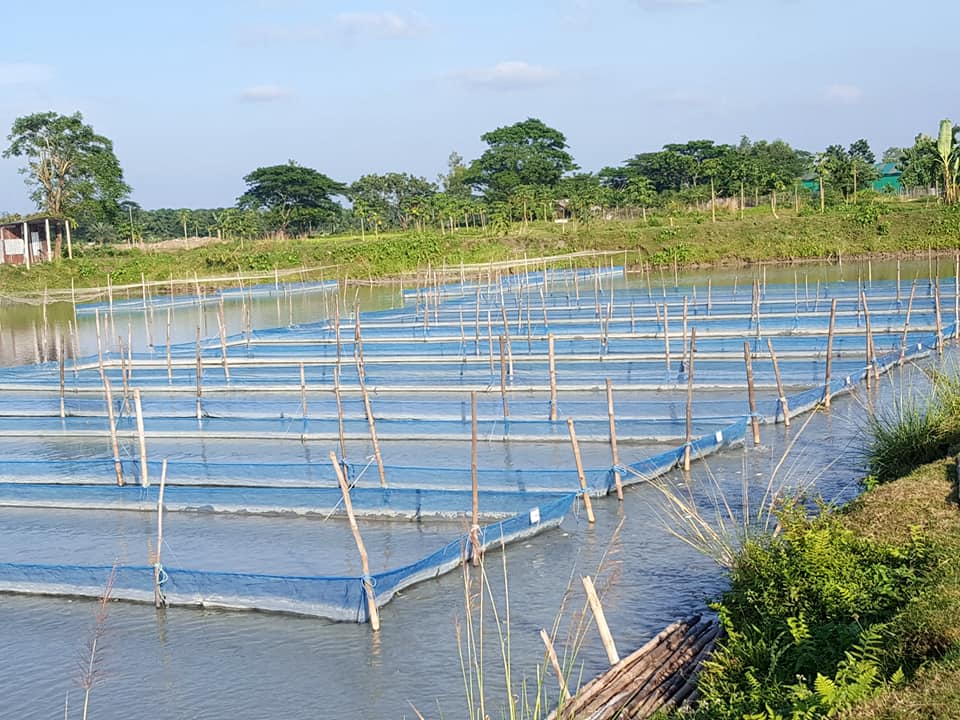Improved Breeding and Farming Practices of Tilapia in Bangladesh-
M. Gulam Hussain
Tilapia egg hatching jars. Photo credit: M. Gulam Hussain
Trend of Genetically Improved Farmed Tilapia Production in Bangladesh
The improved breeding and farming practices of Tilapia in Bangladesh had resulted to the development of Genetically Improved Farmed Tilapia (GIFT) strain of Nile tilapia (Oreochromis niloticus). These GIFT strain of Nile tilapia was introduced in 1994, supplied by WorldFish (formerly ICLARM) under the “Dissemination and Evaluation of Genetically Improved Tilapia in Asia” (DEGITA) project. Research efforts was concentrated on the development and continuous improvement of strains by genetic selection at the Bangladesh Fisheries Research Institute (BFRI) when the GIFT strain was re-introduced in 2005 from Malaysia. Surprisingly, the adoption of low-cost and appropriate breeding and aquaculture technologies in a large number of tilapia hatcheries and farms had generated increased production of tilapia (>18-fold) within a span of 11 years (2005 to 2015) in Bangladesh.
Development of BFRI GIFT nucleus

Genetic selection program was conducted at a closed nucleus of Nile tilapia (Oreochromis niloticus) to manage genetic gain and inbreeding over the 10 years from the establishment of the founder stocks in 2005 to the latest generation in 2015. Between 2012 to 2016, ‘the WorldFish, Bangladesh and South Asia decided to establish a number of “Tilapia Breeding Nuclei” (TBNs) under the Regional Fisheries and Livestock Development Component (RFLDC) of the Danish International Development Agency (DANIDA); the Aquaculture Income for Nutrition (AIN) and the Cereal Systems Initiative for South Asia-Bangladesh (CSISA-BD) projects using 11th generation of the improved GIFT strain collected both from the Jitra Station, Malaysia and the Freshwater Station, BFRI, Bangladesh’.

In 2016, ‘a total of 2,360,000 improved GIFT fry were produced and distributed / sold from these TBNs among 47 tilapia hatcheries in the Rangpur, Jessore, Narail, Fardidpur, Khulna and Barisal regions’. It is expected that between 2020 and 2022, millions of improved GIFT fry would be produced and distributed to the majority of the commercial multiplier tilapia hatcheries in the Southern, Northern and greater Mymensingh regions of the country and beyond and these will be covered and supported by these TBNs.
In 2019, Dr Gulam Hussain has played a pivotal role to ensure that improved breeding and farming practices are adopted in most of the tilapia hatcheries in Bangladesh. He made a visit Yesterday (28 October, 2019) to one of the leading and best Tilapia Breeding Nucleous (TBN) and most modern tilapia and snakehead fish quality seed producing hatchery facilities in the country (Eon Aquaculture Ltd. Fish Farm) at Langulia, Muktagacha, Mymensingh in Bangladesh, Dr Hussain role in these farms is to provide technical assistance and technocentric guidelines as the Chief Aquaculture Advisor to Eon Aquaculture Ltd.







Dr Gulam Hussain visit to Eon Aquaculture Ltd. Fish Farm at Langulia, Muktagacha, Mymensingh in Bangladesh on the 28 October, 2019. Photo credit: M. Gulam Hussain


Great…
LikeLiked by 1 person
Thank you so much Dr Magdy !!
LikeLike